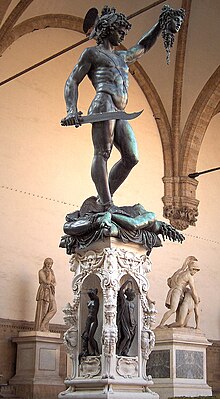
Back Persey Meduzanın başı ilə Azerbaijani Perseus (Benvenuto Cellini) German Perseo con la cabeza de Medusa Spanish Pertseo Medusaren buruarekin Basque Persée tenant la tête de Méduse (Cellini) French Perzej s Meduzinom glavom Croatian Perseo con la testa di Medusa Italian Perseo con la testa de Medusa LFN Perseus (Cellini) Dutch Perseusz z głową Meduzy Polish


Perseus with the Head of Medusa is a bronze sculpture made by Benvenuto Cellini in the period 1545–1554. The sculpture stands on a square base which has bronze relief panels depicting the story of Perseus and Andromeda, similar to a predella on an altarpiece.[1] It is located in the Loggia dei Lanzi in the Piazza della Signoria in Florence, Italy. The second Florentine duke, Cosimo I de' Medici, commissioned the work with specific political connections to the other sculptural works in the piazza. When the piece was revealed to the public on 27 April 1554, Michelangelo's David, Bandinelli's Hercules and Cacus, and Donatello's Judith and Holofernes were already installed in the piazza.[2]
The subject matter of the work is the mythological story of Perseus beheading Medusa, a hideous woman-faced Gorgon whose hair had been turned to snakes; anyone who looked at her was turned to stone. Perseus stands naked except for a sash and winged sandals, triumphant on top of the body of Medusa with her head, crowned with writhing snakes, in his raised hand. Blood spews from Medusa's severed neck. The bronze sculpture, in which Medusa's head turns men to stone, is appropriately surrounded by three huge marble statues of men: Hercules, David, and later Neptune.[2] Cellini's use of bronze in Perseus and the head of Medusa, and the motifs he used to respond to the previous sculpture in the piazza, were highly innovative. Examining the sculpture from the back, one can see a self-portrait of the sculptor Cellini on the back of Perseus' helmet.